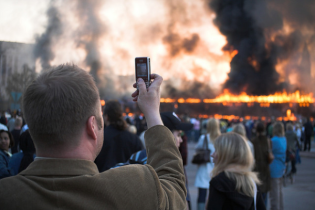
Hamby (2013) explains that during elections, journalists need access to candidates for good reporting and that the mainstream media has become increasingly restricted from this privilege. When reporters spend time with the candidates, they develop richer stories and share “key insights about a candidate” (Hamby, 2013, p. 4) through conversations, body language and other personal observations. Hamby (2013) explains that many news organizations and networks cannot afford to pay journalists and camera crews to follow political campaigns. Additionally, the investment is a gamble if the news organization has the “wrong audience” because Hamby (2013) claims that candidates are more likely to cooperate with organizations that have the biggest audiences or internet traffic. They are also more inclined to work with journalists who will cast them in a positive light.
The digital era is changing the landscape of journalism. The internet allows reporters to send and publish content in a matter of minutes, creating a highly-competitive atmosphere. This means that not only are journalists required to gather information and report stories, they are also expected to be the photographer, camera person, and producer. Hamby argues that digital media platforms like Twitter, Politico, and Buzzfeed, have become increasingly influential with politicians and the American public. As a result, newspapers have been transformed into news organizations that promote a vast array of content through multiple online platforms. Hamby (2013) explains that despite the media’s enhanced ability to publish stories on more platforms than ever, the Pew Research Center found that political candidates and “their allies—spokespeople, cable news surrogates, Super PACs and the like—were the source for about half of the prevailing narratives about the campaigns in the press” (p. 33).

There is less incentive for journalists to check the credibility of their sources or stories because there are few, if any, ramifications. Journalists escape responsibility by using disclaimers that they do not endorse their retweets or that their account is personal and not affiliated with their news organization. Hamby believes that these behaviors reflect a decline in journalistic values. Many reporters, having a narrow perspective of a campaign, tend to make small and seemingly insignificant matters into newsworthy events. Restricting journalists from gaining access to politicians significantly limits the the topics they can cover. This has lead to journalists writing about trivial and superficial matters like a candidate’s appearance or sense of fashion. Smart phones allow reporters to discreetly record audio, video, and images, blurring the distinction between ‘on the record’ and ‘off the record’ statements. As a result, politicians are hesitant in trusting members of the press and the competitive nature of journalism continues to pressure reporters on being the first to break a story. The problem with being first is that it comes with the risk of being incorrect.
This reading made me think of a segment (about 1 minute, 55 seconds into the video) on Last Week Tonight with John Oliver where he exposes the inaccuracies of a Fox News story surrounding the migrant and refugee crisis.
The news station broadcasted a video that depicts refugees on a train singing “Allah is great” with a caption reading “Terrorists Inbound?” During the video’s broadcast, the Fox News anchor explained to the audience that the network is not saying that the individuals shown in the video are terrorists or affiliated with terror groups, but wanted to show how many migrants are Muslim. John Oliver ridicules the disclaimer, arguing that Fox News cannot deny casting the people in the video as terrorists when they deliberately paired it with a caption reading “Terrorists Inbound?” Furthermore, Oliver explains that the video is five years old and was posted on YouTube- before the migrant crisis- in 2010. This means Fox News used outdated footage of a group of Muslim people singing on a train and manipulated the context to create a more sensationalized story. I thought this was a great example of how quickly the mainstream media can report a story without checking their facts or sources. Aside from John Oliver’s segment and other news sources that followed up on the story, I did not find any news showing that Fox News apologized or even commented on their inaccurate and outdated report.
Can we really prevent the media from broadcasting false or misleading information? How can we hold media organizations accountable for the stories they publish? Can you think of an example where a media organization took responsibility for publishing biased or incorrect information? If so, how did they handle the situation?
References
Hamby, P. (2013). Did Twitter Kill the Boys on the Bus? Joan Shorenstein Center on the Press, Politics and Public Policy Discussion Paper Series, 1-95.


